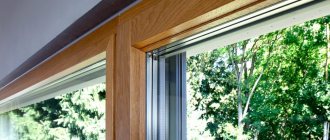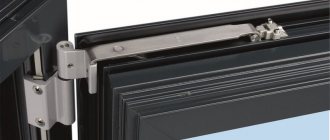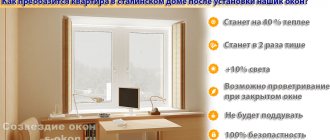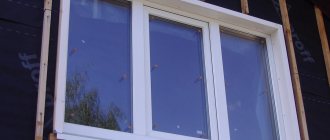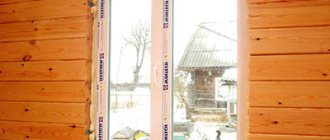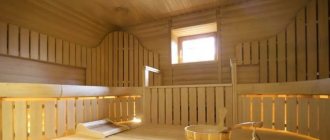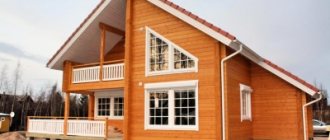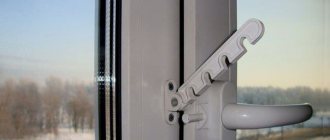Finnish manufacturers succeeded best in this direction, and then almost all popular European window brands implemented the technical idea in their production.
Thus, several modifications of combined Euro-windows appeared on the market: wood-aluminium, aluminum-wood and wood-polyamide-aluminium.
What does the concept mean?
This is a window structure made in the form of a wooden frame, covered on the outside with protective aluminum plates.
Inside there is a built-in double-glazed window and fittings for thermal protection and control of the sashes. The entire structure is inserted into the wall opening and secured with mounting systems to make the house warm and light.
This type of window belongs to combined window structures, among which the following subtypes are distinguished :
- wood-aluminum (D-A) - wood base, aluminum outer lining;
- aluminum-wood (A-D) - aluminum base, wood outer lining;
- wood-polyamide-aluminum (D-P-A) - the base is wood, the outer lining is aluminum, a layer of polyamide is arranged between them.
Where and when can they be used?
The installation sites for combined windows are residential, industrial and public buildings. Each of the 3 varieties of such structures has its own protective characteristics , which is why they are preferable for installation at certain facilities.
Thus, wood-aluminum blocks are installed in cold latitudes, since they are warmer. They are not recommended to be installed in particularly humid environments and in industrial facilities; aluminum-wood ones will be more reliable there. These window modifications also work well in southern areas.
Additionally . Wood-polyamide-aluminum windows have greater thermal resistance than the other two modifications, since an additional protective layer of polyamide is installed as protection between the main wood and the protective aluminum strip. It is recommended for use in areas with large temperature differences in winter.
Advantages of wood-aluminum windows
The main advantage of such models and the difference from basic prototypes made only of wood is durability.
The use of metal as an exterior material has made wood-aluminum windows weather-resistant. Thanks to this technology, the structure is reliably protected from the street. After all, it is this area of wooden windows that is considered the most vulnerable. Thanks to the use of lightweight and durable metal, the problem was solved. However, durability and the ability to preserve wood on the outside for a long time are not the only advantages of such windows. They have other advantages:
- energy efficiency – wood is an excellent heat insulator;
- environmental friendliness - practically no synthetic materials are used in the manufacture of such models;
- respectable appearance - you can choose any type of wood for the inside of the windows;
- structural stability - the use of aluminum profiles minimizes the risk of deformation;
- versatility - windows are suitable for use in any facility.
Previously, such structures had a serious flaw - an aesthetic imbalance, which was caused by the fact that the windows looked elegant from the inside, but too simple from the street. For this reason, they did not want to install such products in respectable cottages and houses made of logs or timber. The problem was eventually eliminated through the use of aluminum profile lamination technology. Thanks to this technique, it was possible to achieve a reliable effect of natural wood on the outside of the windows.
The aluminum profile reduces the total weight of the windows, which reduces the load on fittings and fasteners. However, at the same time, it reduces the level of thermal insulation, so you need to take a balanced approach to choosing the type of construction of such windows.
Types of products with linings
Modern combined structures made of aluminum and wood are replacing wooden ones, which is especially important in northern countries that experience a shortage of wood: Finland, Sweden and Norway. Here, up to 70% of wood-aluminum blocks are installed.
In warmer countries: Spain, Italy and France, up to 55% of aluminum-wood structures are installed, while in Portugal they are predominant, with installations of up to 90% in the residential sector. These windows do not belong to the cheap or even middle price category , but the service life that manufacturers promise to buyers up to 100 years contributes to the fact that many of them agree to invest huge sums in the windows of their household.
Wood-aluminum
The leaders in the production of D-A window systems are all northern countries, including Sweden and Finland, as well as Germany. For standard residential buildings, they consist of two or three sashes, with two- or three-chamber double-glazed windows, the connection between the sashes is made using metal rods. Finnish designs are especially heavy; they may have an additional external aluminum frame; the thickness of such a block sometimes reaches 200 mm.
Most popular manufacturers:
- Finland: Skaala, Fenestra, Domus, Tivi and Lammin, average cost of 1 m2 from 59,000 rubles;
- Sweden: Sokolka and SSC, average cost of 1 m2 from 52,000 rubles;
- Germany: Gutmann, Unilux and Kneer average cost of 1 m2 from 55,000 rubles.
Wood-aluminum windows are described in this video:
Aluminum-wood
The base of aluminum-wood windows is an aluminum frame decorated with wooden overlays. Aluminum bears the main load, performing a supporting function .
The combination of the properties of the two materials creates high performance blocks that fully comply with the requirements of Russian GOST and SNiP for energy efficiency and strength, so they are allowed for installation in almost all types of buildings. The use of wood overlays in these designs creates quite a wide potential for designers.
The most popular windows of the “A-D” group are models from Italian companies:
- New Tec Group with a thermal gap of 24 mm, average cost of 1 m2 from 32,000 rubles;
- GRAND and GRAND+ with assembled thickness - 119.7 mm and 133 mm, average cost of 1 m2 from 36,000 rubles;
- Perla, average cost of 1 m2 from 29,000 rubles;
- Mixall, average cost of 1 m2 from 31,000 rubles.
Wood-polyamide-aluminum
This design has greater thermal resistance due to the installation of a polyamide layer in the air space between the aluminum and the wooden frame. For cold regions of Russia, it should be at least 2.5 cm. The tree can be installed: pine, the most budget option, larch with an average price and expensive oak, its price is usually 30-40% higher than pine.
The most popular companies on the Russian market that produce wood-polyamide-aluminum windows:
Finnish company Tiivi, average cost of 1 m2 from 49,000 rubles;- Finnish company Lammin IKKUNAT, average cost of 1 m2 from 48,000 rubles;
- Austrian company Gaulhofer, average cost of 1 m2 from 450,000 rubles;
- Swedish company SSC Joinex, average cost of 1 m2 from 42,000 rubles;
- Russian company STOLLER, average cost of 1 m2 from 29,000 rubles;
- Russian, average cost of 1 m2 from 28,000 rubles;
- Russian, average cost of 1 m2 from 26,000 rubles.
Window shape
When using combined profiles, not only structures of standard rectangular or polygonal shapes are made. Thanks to the advent of special equipment for bending aluminum, today it is possible to produce arched windows. However, the production time for such products will be longer, since it is necessary to shape not only metal components, but also wooden elements, and this requires much more time.
Detailed description of the structure
All three groups of wood-aluminum windows are structurally different from each other, since they have a different base - the window frame.
The main features of wood-aluminum windows:
- The main frame is a reinforced profile made of laminated veneer lumber with 3 lamellas.
- The outer surface of the frames is an optimally shaped aluminum lining that prevents the accumulation of moisture; the surface of the lining is painted with powder dye.
- High-quality two- and three-chamber double-glazed windows with increased heat and noise insulation.
- European-made fittings have a trouble-free operation period of 10 years, designed for 10,000 opening/closing cycles.
The main differences between aluminum and wood windows:
- The main frame is made of aluminum, high strength, frost resistance and moisture resistance.
- The outer surface of the frames is a wooden overlay.
- High-quality two- or three-chamber double-glazed windows with increased heat and noise protection.
- European-made fittings, tilt and turn with compression around the perimeter of the sash and 3 sealing contours.
The main differences between wood-polyamide-aluminum window structures:
- The main frame and sash are made of wood and plastic.
- The outer surface of the frames is painted aluminum.
- High-quality two- and three-chamber double-glazed windows with increased heat and noise insulation.
- European-made swing-out fittings with two sealing circuits.
Design
When choosing a finish, all interior/exterior features are taken into account. To order, any options for window profiles and finishes are possible - tinting in any shade and color, brushing wood, patination, whitening, overlays on double-glazed windows.
Bleaching
Tinted and aged surface
Golden oak finish
Walnut color
Brushing
Technical specifications
Window systems, which are manufactured using the technology of combining two and three standard window materials: wood, aluminum and plastic, have absorbed all their positive characteristics, although they still differ from each other depending on the modification of the Eurowindow .
Technical characteristics of wood-aluminum blocks:
- Profile width 78 mm and above.
- Sound insulation, Rw=53 dB.
- Thermal protection, 1.0 W/m2K.
- Frost resistance, above F50.
- Impermeability to water, class. A-8 according to EN-12208.
- Air tightness, 4.0 cl. according to EN-12207.
- Characteristics of glass block, 42 mm.
- The characteristics of the external coating are European glazes REMMERS, ADLER, RAL and SIKKENS.
- Safety, WK-3 class. ENV-1627-1630.
Technical indicators of aluminum-wood blocks:
- Aluminum profile width, over 60 mm.
- Sound insulation, Rw=33 dB.
- Thermal protection, 0.6 W/m2K.
- Frost resistance, above F100.
- Characteristics of glass block, 34 mm
- Characteristics of the external covering are wood: linden, larch and oak.
Technical characteristics of wood-polyamide-aluminum:
- Profile width, wood - 78 mm and polyamide - 24 mm.
- Sound insulation, Rw=53 dB.
- Thermal protection, 0.6 W/m2K.
- Frost resistance, up to F50.
- Characteristics of glass block, 42 mm.
- Polyamide thermostat, up to 24 mm.
- Impermeability to water, class. A-8 according to EN-12208.
- Air tightness, 4.0 cl. according to EN-12207.
- Thermal protection from 3 circuits of EPDM seals.
- The characteristics of the external coating are European glazes REMMERS, ADLER, RAL and SIKKENS.
- Safety, WK-3 class. ENV-1627-1630.
Customer Reviews
Wood-aluminum, as well as aluminum-wood windows, are still just taking root in the Russian market. In this connection, on thematic forums there are often comments regarding the high cost and lack of a tilt-and-turn mechanism in some (Finnish) designs. Therefore, before ordering wood-aluminum windows, buyers are advised to check with the supplier about the availability of this option, otherwise in the rain the window will have to be closed completely, and this is inconvenient.
Some note that aluminum-wood windows and aluminum-wood combined doors are not only unaffordable for them, but are also environmentally friendly, which in Russian reality is not a priority characteristic. However, negative reviews are usually left by those who have not decided to purchase combined models. Those who have become their owners unanimously note the highest quality, ease of use, durability and, of course, the beauty of such structures.
Tips for choosing the right type
Before choosing the right combination window, you need to take into account the climatic operating conditions .
In the northern regions, wood should predominate in the structure, while in the southern regions, aluminum and plastic should predominate, since such structures are much cheaper, but at the same time have lower thermal resistance.
When choosing a specific type of aluminum-wood window, the developer must familiarize himself with the quality certificate for the product and pay attention to the following characteristics:
- The quality of the frame material, for wood - a three-layer beam of at least 78 mm made of oak or larch, coated with environmentally friendly impregnations, for aluminum - a profile made in Europe, Germany or Sweden.
- Double-glazed windows - 2-chamber and three-chamber with glass of at least 4 mm, for cold areas up to 6 mm.
- Windows with increased noise protection have different distances between the panes.
- Type of glass: from ordinary float glass to selective glass that maintains an optimal microclimate; vandal-proof structures require the installation of triplex glass.
- Seals, preferably EPDM or silicone.
- A ventilation system is mandatory in these structures, because unlike natural wooden frames, which ventilate up to 60 liters of moisture per day, combined structures with aluminum can only provide 3 liters.
- The following ventilation systems are recommended: micro-slit ventilation, installation of a comb and a window.
- The fittings must ensure a trouble-free opening/closing cycle of at least 10,000 times and a trouble-free operation period of at least 10 years.
Methods for opening combination windows
Absolutely all combined windows, with the exception of fixed models made of aluminum-wood profile systems, are functional products. Thanks to the ability to integrate almost any fittings, the customer has the opportunity to order models with the following methods of opening the doors:
- tilt and turn;
- parallel-sliding;
- mid-mounted;
- folding.
Most opening systems have the ability to work in combination with window automation. This allows you to remotely control the shutters and connect the windows to the Smart Home system.
Installation Features
Modern developments of combined Euro-windows are adapted to Russian market opportunities. Almost every experienced home craftsman is able to cope with this work on his own.
To do this, he will need the following tools and equipment::
- electric screwdriver;
- powerful electric hammer drill with drill;
- construction measuring instruments: slope, level, angle, ruler and tape measure;
- simple metal scissors, for cutting canopies and trims;
- plates and anchors for fastening the frame;
- bars or wedges for mounting the structure in the opening.
Technology for installing aluminum-wood windows when replacing old structures:
- They prepare the opening, dismantle the old windows and clear it of debris and sealant residues; the cleaning is carried out up to the wall of the opening.
- A new wooden beam, treated from rotting and burning, is installed in the opening, it is leveled and fixed with anchors.
- The frame is assembled using sealing inserts.
- Mounting plates are secured to the top and sides.
- Install the frame in the opening, on the support bars.
- The bottom is fixed with anchors, and the top and sides are fixed with plates prepared in advance for installation.
- The individual frame structures are connected to each other using insert profiles.
- Install the visor, flashings and drainage strip.
- Secure the window sill from inside the room.
- Install the upper part of the sash, insert it into the frame groove, onto the guides.
- Install insulation if they are not installed by the manufacturer.
- Install all the fittings: handles, latches and stops.
Setup and use
Modern wood-aluminum window units come pre-configured from the manufacturer. If the user has installed and assembled the kit according to factory instructions and ensured that the window is level horizontally and vertically, no special adjustment is required.
Important ! It is possible that when opening and closing for the first time, a looseness of the valves will be noticed, then they will need to be adjusted. The adjustment technology depends on the installed fittings and the principle of operation of the sashes. It is indicated in the product passport.
Also, these windows do not require large amounts of periodic maintenance , as was the case with Soviet wooden windows. The list of mandatory maintenance of aluminum-wood windows includes the following activities:
- The paintwork on exposed wooden overlays requires renewal once every 12 months.
- Clean windows at least once every 3 months and as needed, but do not use aggressive solvents.
- Lubricate the seals once every six months with special solutions or glycerin.
Where to buy wood aluminum windows in Moscow?
You can buy wood and aluminum windows in Moscow and the region everywhere. Priority is given to the aluminum-wooden lines of Schuco schuco, Allywood, Aldo, Reinaers, as well as the above brands of German, Finnish and Swedish windows. All these brands can be bought in Moscow (what are the prices for wooden windows in Moscow today and what type to choose for yourself, read our separate article.)
Domestic manufacturers of aluminum windows with wood profiles in Russia also deserve attention, especially as a budget option.
An important point that you should pay attention to when ordering wood-aluminum products is the equipment and professionalism of the installers. Due to improper installation, for example, a Finnish window, the outer single glass may sweat and even become covered with frost. This will not happen if you buy only original products from companies that have been working with such products for more than one year. It is also worth taking out a guarantee that includes free repairs.
Pros and cons of use
Domestic and foreign manufacturers of aluminum-wood windows have done everything possible to ensure that they incorporate the best characteristics of wooden and aluminum structures.
Experts and users include the following advantages of such aluminum windows:
- High protection from atmospheric influences: moisture, sun, and cold wind.
- High level of thermal resistance, higher than that of wood and aluminum systems.
- High frost resistance on average above F50.
- Durability and reliability, ability to work from 50 to 100 years.
- Low maintenance.
- Environmentally friendly.
- High aesthetic design.
The main disadvantage of aluminum-wood windows is their high cost, 30-40% higher than purely wooden or aluminum ones. However, this disadvantage is neutralized by the long service life of such structures and high energy efficiency, which pays off in the first 4-5 years thanks to energy savings on the heating system.
User reviews
This type of windows is very common in most northern countries, and in our country they began to be installed relatively recently . However, the excellent characteristics of aluminum windows with wood are loved by many owners of private houses. Some of them share their reviews on the pages of online forums, here are some of them:
- A good profile of an aluminum-wood window from Alutech.
- The NewTec-Wood system has an aluminum profile designed for self-installation of wood overlays.
- During normal assembly, wood-aluminum functions without problems.
- Aluminum-wood windows have all the advantages of both types of windows.
- Wooden windows with overlays are well protected from the outside from sunlight and rain.
- Western models have higher thermal conductivity.
- In such windows, “wooden linings” increase the price by at least 2 times than for a regular aluminum window.
You can read reviews here, here and here.
Types of salaries
When temperature changes, wood and aluminum structures retain their original parameters and do not dry out or deform. The color of the profile can be selected according to the RAL scale (more than two hundred shades); it is also possible to coat it with tinting varnish. The surface is resistant to ultraviolet radiation, does not fade, and does not fade in the sun. The manufacturing price depends on the size of the structure, configuration, materials used, fittings, etc. Managers pre-calculate the cost and agree with the customer. For additional information and price calculation, call the operator or request a call back.
Average price range
These window designs are expensive products, and they differ in price depending on the type of wood (the most expensive is oak), geometric dimensions, configuration, configuration, number of opening sashes, thickness of the glass unit, quality of fittings and brand.
Domestic ones are up to 30% cheaper than their Western counterparts.
Average prices for such products in Moscow per 1 m2, depending on the manufacturer and type of wood:
- Double-leaf, Russia, pine trim - 25,000 rubles.
- Double-leaf, Germany, larch overlay - 35,000 rubles.
- Double-leaf, Sweden, oak trim - 40,000 rubles.
Classic and seamless aluminum
Two types of aluminum are used - seamless and classic. They differ in the seam on the surface and in cost (the price of seamless is 1950 rubles/sq.m.). This does not affect the quality.
Classical
Modern seamless
If the goal is to create a more modern design, then a seamless material will do.
